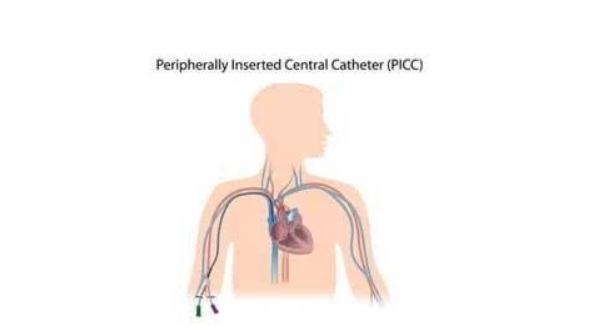By: Thalia Kaylyn Averil
Access to the central venous system is carried out using a Central Venous Catheter (CVC) or Peripherally Inserted Central Catheter (PICC). This is necessary for intravenous therapy, blood sampling, monitoring, and various other medical procedures, especially when peripheral venous access is not possible. CVC comes in tunneled and non-tunneled types. Tunneled CVC is inserted from beneath the skin towards the cannulation point, while non-tunneled CVC is directed straight to the cannulation point. Therefore, non-tunneled CVC needs to be replaced every few days to a week, while tunneled CVC can remain in place for weeks or even months. On the other hand, PICC is usually recommended for short to medium-term use, ranging from 4 weeks to 6 months.
The CVC insertion procedure involves placing a catheter directly into large veins, such as the femoral vein, internal jugular vein, subclavian vein, superior vena cava, or inferior vena cava. This is different from PICC installation, which places the catheter in veins located in the arm, such as the basilic vein, brachial vein, cephalic vein, or median cubital vein. Those veins will converge into one of the major veins located around the heart, namely the superior vena cava. PICC uses the Seldinger technique, which consists of puncturing the vein with a needle, inserting a guidewire into the vein, and then moving the catheter along the guidewire. Both procedures often use ultrasound guidance to reduce complications and increase first-pass success, but ultrasound is more frequently used in CVC.

Figure 1. Central Venous Catheter (CVC).

Figure 2. Peripherally Inserted Central Catheter (PICC).
Indications for CVC are:
- Infusions that are not compatible with peripheral venous access, such as vasopressors, chemotherapy, total parenteral nutrition, and acidic drugs.
- Health workers are unable to obtain peripheral venous access in an emergency.
- Initiation of extracorporeal therapy, such as continuous renal replacement therapy, plasmapheresis, and hemodialysis.
- Hemodynamic monitoring, such as central venous pressure measurement.
- Venous interventions, such as installing a filter in the inferior vena cava, thrombolytic therapy, transvenous cardiac pacing, and intravenous stent placement.
Indications for PICC are:
- Patients who require venous access for several weeks or months typically use PICC due to its lower infection rate.
- Limited peripheral venous access.
- Long-term intravenous medication, such as fungal medication or antibiotics.
- Administration of vesicants or drugs that can irritate peripheral veins, such as vasoactive drugs and chemotherapy.
- Administration of hyperosmolar solutions with extreme pH, such as total parenteral nutrition.
- Transfusion of blood products, such as red blood cells, plasma, platelets, etc.
- Frequent and regular blood draws.
- Patients who experience coagulation disorders, such as thrombocytopenia.
- PICC is indicated for patients with anatomical abnormalities in the chest and neck who may experience difficulties during CVC placement.
CVCs can provide direct access to administer medications, blood products, nutrients, or fluids into the bloodstream, which is especially advantageous in emergency situations. However, the CVC installation procedure is more invasive, increasing the risk of complications, such as infection and pneumothorax. In recent years, the use of PICC has increased as an alternative to CVC, especially in the fields of oncology and critical care, because it is considered easier to insert and safer. PICCs can reduce the risk of catheter-related infections and sepsis, but they can increase the risk of venous thrombosis or the formation of blood clots in the veins.
| Central Venous Catheter (CVC) | Peripherally Inserted Central Catheter (PICC) |
| Can be used for weeks or months | Used for short to medium-term use, ranging from 4 weeks to 6 months |
| The catheter is directly placed in a large vein, making it more recommended for use in emergency situations | The catheter is placed in a small vein located in the arm, which will converge into the superior vena cava, one of the large veins around the heart |
| The procedure is more invasive compared to PICC | The procedure is less invasive compared to CVC |
| The risk of complications, such as infection and pneumothorax, is greater | The risk of infection and sepsis is smaller |
| The risk of venous thrombosis is smaller | The risk of venous thrombosis is greater |
Resources
- Santos FKY, Flumignan RLG, Areias LL, Sarpe AKP, Amaral FCF, Ávila RB, Vasconcelos VT, Guedes Neto HJ, Amorim JE, Nakano LCU. Peripherally inserted central catheter versus central venous catheter for intravenous access: A protocol for systematic review and meta-analysis. Medicine (Baltimore). 2020 Jul 24;99(30):e20352. Available from: https://www.ncbi.nlm.nih.gov/pmc/articles/PMC7386962/
- Schmidli J, Widmer MK, Basile C, et al. Editor’s choice—vascular access: 2018 Clinical Practice Guidelines of the European Society for Vascular Surgery (ESVS). Eur J Vasc Endovasc Surg 2018;55:757–818. https://pubmed.ncbi.nlm.nih.gov/29730128
- Johansson E, Hammarskjöld F, Lundberg D, Arnlind H. Advantages and disadvantages of peripherally inserted central venous catheters (PICC) compared to other central venous lines: A systematic review of the literature. Taylor & Francis Online. 2013 Mar 11;52(5). Available from: https://www.tandfonline.com/doi/full/10.3109/0284186X.2013.773072
- Kolikof J, Peterson K, Baker AM. Central Venous Catheter. [Updated 2023 Jul 26]. In: StatPearls [Internet]. Treasure Island (FL): StatPearls Publishing; 2023 Jan-. Available from: https://www.ncbi.nlm.nih.gov/books/NBK557798/
- Gonzalez R, Cassaro S. Percutaneous Central Catheter. [Updated 2023 Sep 4]. In: StatPearls [Internet]. Treasure Island (FL): StatPearls Publishing; 2023 Jan-. Available from: https://www.ncbi.nlm.nih.gov/books/NBK459338/
